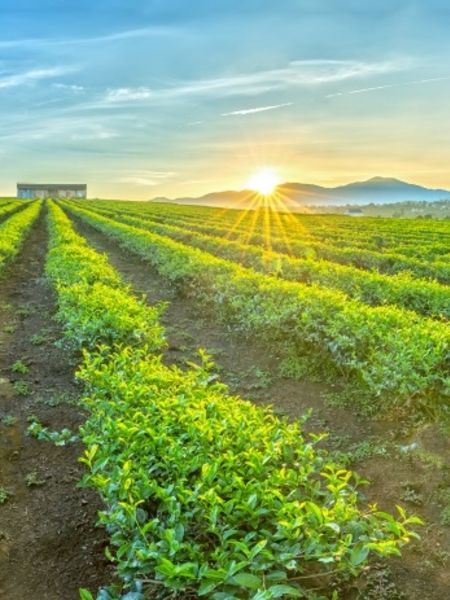ALL ABOUT TEA: Pu Erh


Puerh is a tea full of contradictions.
It is not fresh, but intentionally and carefully aged, sometimes for decades. It does come in loose leaf varieties but generally puerh comes in a compressed form: bricks, rounds, knobs, balls. It always begins as green tea despite its dark color. And, it is a signature tea from the province of Yunnan in mainland China.
Puerh (aka Pu-er) is named for the town where the tea was originally processed and marketed and referred to by the Chinese as heicha or dark tea. Cantonese speakers call it boh-lay.
Puerh evokes mystery, not just from the legends surrounding its processing, but from its wide range of flavors and aromas, at once rough and earthy or heavily smooth to a fruity sweetness in others.
Puerh cakes (tuan cha) demonstrate how clever the tea makers were to discover a way to ensure the longevity of their tea carried by traders traveling on the historic Silk Road, often for a year at a time.
On these travels, puerh’s naturally high moisture content caused natural fermentation to occur in what began as green or raw tea (sheng cha) and resulted in a dark finished tea (shou cha.) What began as an error (unexpected fermentation) ended up being a wholly new category of tea. By perfecting the tea’s evolution from green to dark intentionally, shaping it, and forming it into bricks, balls or cakes, the tea processors and the traders both benefitted from the original “long shelf life” tea. Some puerh processors have puerhs 20-50 years old which are highly prized by their customers.
All puerh tea begins as green or raw tea (sheng cha) and the highest quality begins with Yunnan’s spring harvest of its big leaf cultivar, (da ye.) The small leaf buds, highly prized for their silvery or golden tips, frequently garnish compressed tea forms. Summer and fall harvests can also result in puerh teas, although considered lower in quality to spring harvests.
HOW IT IS PROCESSED
The leaves are withered slightly, pan fired, then rolled into shapes before placing under sunlight to air dry. Or, they’re dried on bamboo mats over a charcoal fire which results in a strong smoky taste some find harsh or bitter and others find pleasingly strong.
Tuan cha or cake tea, those round forms of tea are generally a blend of three different grades of tea. The harsher tasting leaves are in the core, the less tippy leaves on the bottom, and the most appealing tippy leaves are placed on the top. (By breaking/cutting off a piece of a disc for brewing, one gets a little of all three grades.)
The leaves are then placed in a cloth bag, steamed, then placed in a mold that presses the leaves into the traditional disc shape. (Oldtimers might press the disc via two large stones.) The discs are cooled then left in the sun to dry.
Many shapes are available: round (bing cha,) bowl tea (tuo cha) which is a knob of tea that is made in many different sizes, the legendary brick tea (zhuan cha,) once allegedly used as currency, and bamboo tea which is packed into tubes of bamboo to infuse the tea with its scent.
HEAT AND MOISTURE ARE POSITIVES FOR PUERH
Because of puerh’s larger leaf size, the elements of heat and moisture prove beneficial where, if applied to other types of processed tea, they would be ruinous, drawing mold and fungi.
By expanding and contracting in reaction to absorbing and releasing moisture, the large puerh leaves release their own juices repeatedly which allows for positive bacteria and enzyme activity, the source of both its flavor and its fragrance and, some say, the digestive benefits of puerh. One legend is that cooks often use leftover tea to rinse the grease off their woks; imagine what it can do to your digestive tract!
Shou cha puerh can be produced either in compressed form or loose leaf. Fermentation is induced by adding water to a pile of leaves then covering them with a tarp. The tarp is removed often during the processing period to allow heat and moisture to be released and to provide even fermentation to all the leaves. When processing is completed, the leaves are spread out to dry and the fermentation is stopped.
HOW TO BREW
Most tea vendors suggest boiling water for puerh, and for some of the hearty earthy types, that is a possible choice, however, a tippy sheng cha will become quite bitter with boiling water and its fruity sweetness will be overwhelmed. Sheng cha puerhs should, instead, be brewed with hot but not boiling water as you would a green tea, brewing one to three minutes in water heated to 185-195 degrees F.
Shou cha loses some of its astringency via its processing, so hotter water emphasizes the earthiness and sweet edge. Brew with hot water (190-200 degrees F.) up to three minutes. For the best result, allow the infused tea to cool a bit before drinking. Think of it as allowing a wine to breathe.
The silkiness of a long-aged puerh is truly unforgiving and near boiling water not only does no harm it actually enhances the smoothness. Brew with hot water (195-205 degrees F.) for three minutes.
As with all brewing and temperature suggestions, adjust to your taste.
NOTE: In puerh processing, it is indeed a form of fermentation: bacteria is formed by adding water to the leaves. In the processing of other teas, it is not fermentation, but oxidation that is used to eliminate degrees of moisture to make the leaves pliable for shaping. No moisture is added for white, yellow, green, oolong, or black tea processing.
